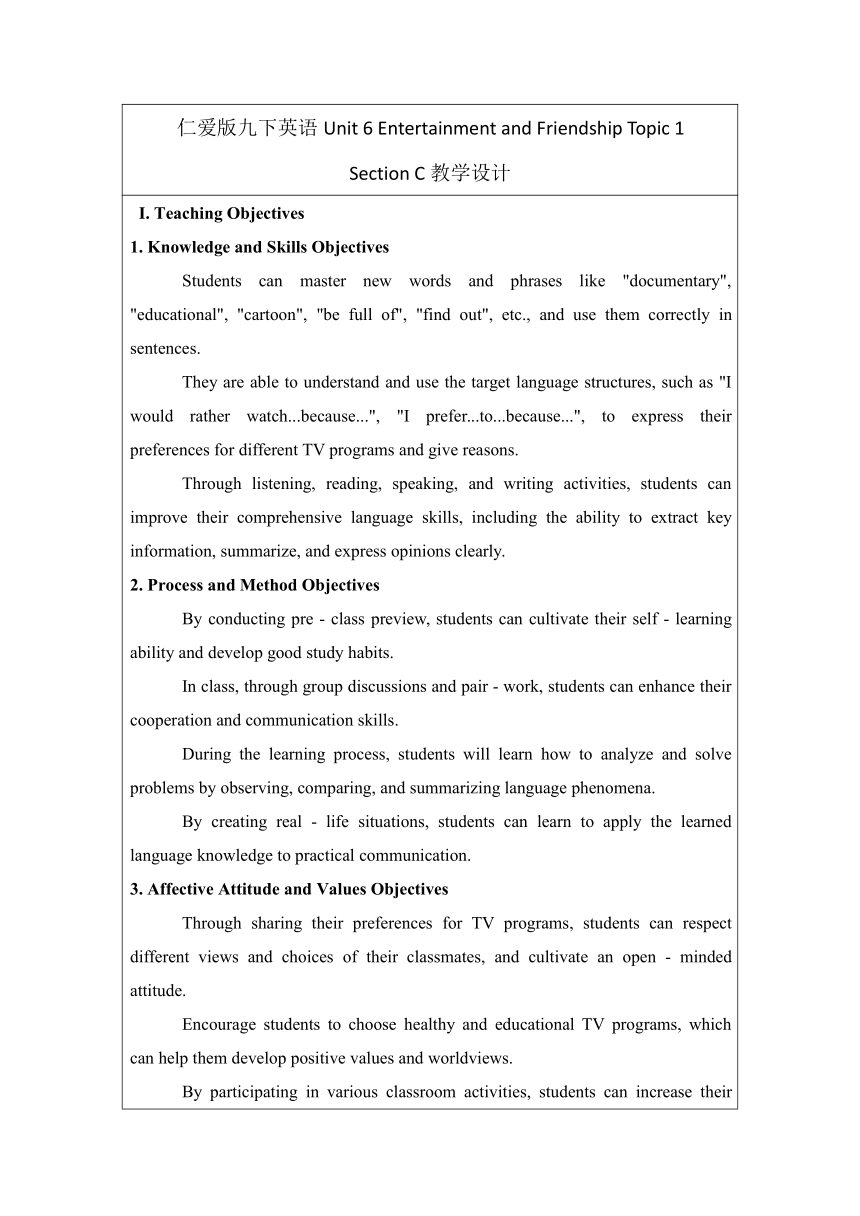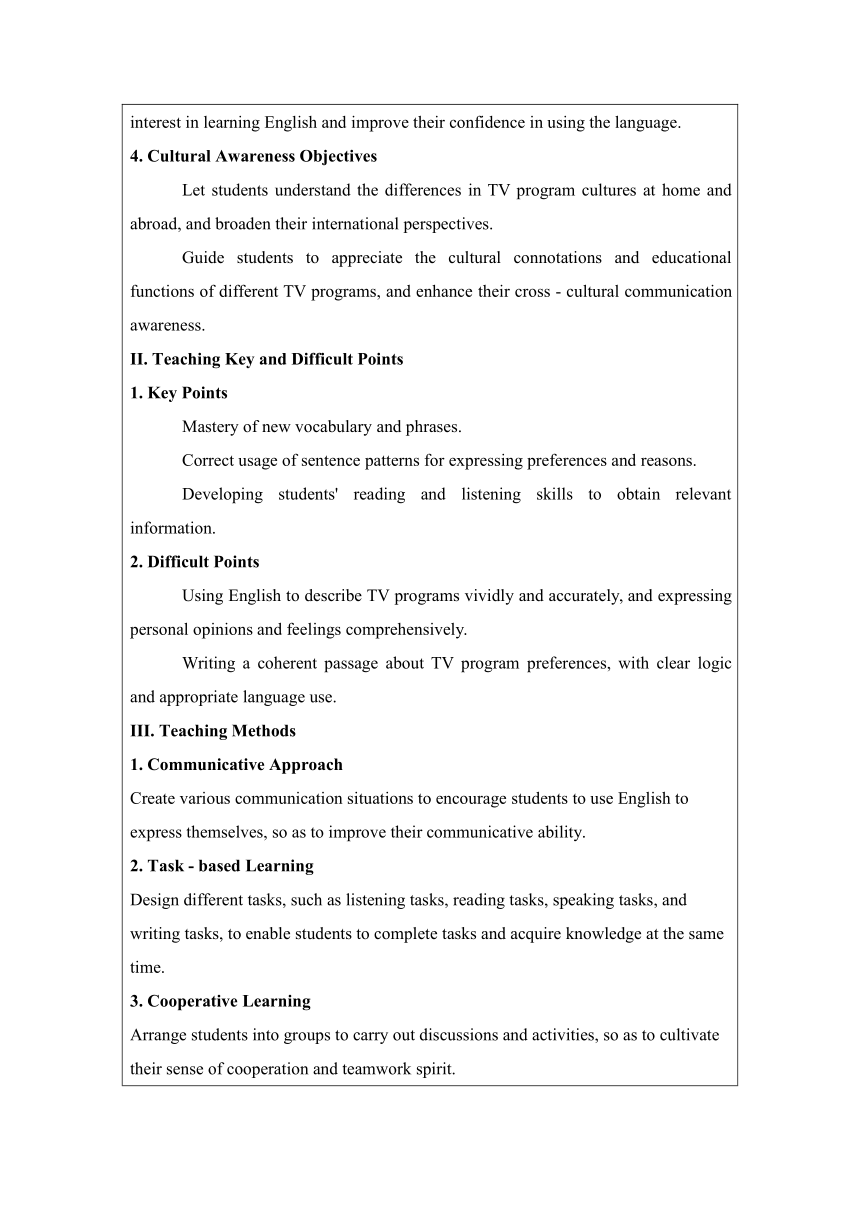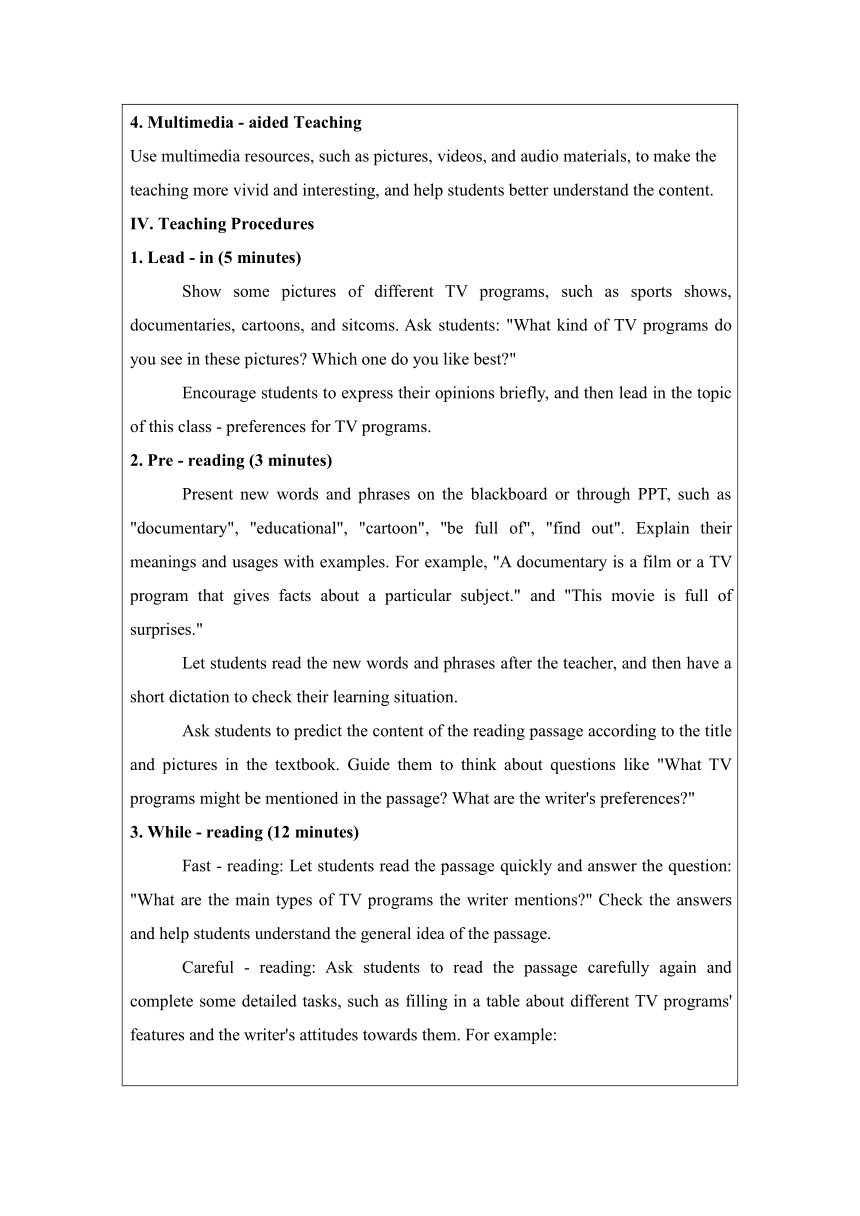仁爱版九下英语Unit 6 Entertainment and Friendship Topic 1 Section C 教学设计(表格式)
文档属性
| 名称 | 仁爱版九下英语Unit 6 Entertainment and Friendship Topic 1 Section C 教学设计(表格式) |  | |
| 格式 | doc | ||
| 文件大小 | 75.4KB | ||
| 资源类型 | 教案 | ||
| 版本资源 | 仁爱科普版 | ||
| 科目 | 英语 | ||
| 更新时间 | 2025-01-20 20:47:03 | ||
图片预览



文档简介
仁爱版九下英语Unit 6 Entertainment and Friendship Topic 1 Section C教学设计
I. Teaching Objectives1. Knowledge and Skills ObjectivesStudents can master new words and phrases like "documentary", "educational", "cartoon", "be full of", "find out", etc., and use them correctly in sentences.They are able to understand and use the target language structures, such as "I would rather watch...because...", "I prefer...to...because...", to express their preferences for different TV programs and give reasons.Through listening, reading, speaking, and writing activities, students can improve their comprehensive language skills, including the ability to extract key information, summarize, and express opinions clearly.2. Process and Method ObjectivesBy conducting pre - class preview, students can cultivate their self - learning ability and develop good study habits.In class, through group discussions and pair - work, students can enhance their cooperation and communication skills.During the learning process, students will learn how to analyze and solve problems by observing, comparing, and summarizing language phenomena.By creating real - life situations, students can learn to apply the learned language knowledge to practical communication.3. Affective Attitude and Values ObjectivesThrough sharing their preferences for TV programs, students can respect different views and choices of their classmates, and cultivate an open - minded attitude.Encourage students to choose healthy and educational TV programs, which can help them develop positive values and worldviews.By participating in various classroom activities, students can increase their interest in learning English and improve their confidence in using the language.4. Cultural Awareness ObjectivesLet students understand the differences in TV program cultures at home and abroad, and broaden their international perspectives.Guide students to appreciate the cultural connotations and educational functions of different TV programs, and enhance their cross - cultural communication awareness.II. Teaching Key and Difficult Points1. Key PointsMastery of new vocabulary and phrases.Correct usage of sentence patterns for expressing preferences and reasons.Developing students' reading and listening skills to obtain relevant information.2. Difficult PointsUsing English to describe TV programs vividly and accurately, and expressing personal opinions and feelings comprehensively.Writing a coherent passage about TV program preferences, with clear logic and appropriate language use.III. Teaching Methods1. Communicative ApproachCreate various communication situations to encourage students to use English to express themselves, so as to improve their communicative ability.2. Task - based LearningDesign different tasks, such as listening tasks, reading tasks, speaking tasks, and writing tasks, to enable students to complete tasks and acquire knowledge at the same time.3. Cooperative LearningArrange students into groups to carry out discussions and activities, so as to cultivate their sense of cooperation and teamwork spirit.4. Multimedia - aided TeachingUse multimedia resources, such as pictures, videos, and audio materials, to make the teaching more vivid and interesting, and help students better understand the content.IV. Teaching Procedures1. Lead - in (5 minutes)Show some pictures of different TV programs, such as sports shows, documentaries, cartoons, and sitcoms. Ask students: "What kind of TV programs do you see in these pictures Which one do you like best "Encourage students to express their opinions briefly, and then lead in the topic of this class - preferences for TV programs.2. Pre - reading (3 minutes)Present new words and phrases on the blackboard or through PPT, such as "documentary", "educational", "cartoon", "be full of", "find out". Explain their meanings and usages with examples. For example, "A documentary is a film or a TV program that gives facts about a particular subject." and "This movie is full of surprises."Let students read the new words and phrases after the teacher, and then have a short dictation to check their learning situation.Ask students to predict the content of the reading passage according to the title and pictures in the textbook. Guide them to think about questions like "What TV programs might be mentioned in the passage What are the writer's preferences "3. While - reading (12 minutes)Fast - reading: Let students read the passage quickly and answer the question: "What are the main types of TV programs the writer mentions " Check the answers and help students understand the general idea of the passage.Careful - reading: Ask students to read the passage carefully again and complete some detailed tasks, such as filling in a table about different TV programs' features and the writer's attitudes towards them. For example: TV Program FeaturesWriter's Attitude Sports shows Full of excitement LikesDocumentaries Provide plenty of informationLikes After that, ask students to explain the sentences they don't understand. The teacher gives explanations and helps students analyze the key sentence structures in the passage, especially those related to expressing preferences.4. Post - reading (5 minutes)Group discussion: Divide students into groups of four or five. Ask them to discuss the following questions: "What TV programs do you and your family usually watch Why do you like them " Each group member needs to share their ideas, and the group leader takes notes.Then, ask each group to report their discussion results to the whole class. The teacher listens carefully and gives comments and feedback, guiding students to use the target language structures correctly.5. Listening (5 minutes)Before - listening: Show some pictures related to the listening content, which may include different TV presenters and scenes of TV programs. Let students predict what they will hear, such as "What kind of TV program is being introduced Who is the host "While - listening: Play the audio material. Let students listen for the first time to get the general idea and answer the question: "What is the main topic of the conversation " Then play it again, and ask students to complete some detailed exercises, like filling in blanks with missing information about the TV program's time, content, and the speakers' opinions.After - listening: Check the answers with students. Let students read the listening text aloud to practice pronunciation and intonation. And ask students to imitate the conversation in pairs, paying attention to the way of expressing preferences.6. Writing (10 minutes)Writing guidance: Present a writing task to students: "Write a short passage about your favorite TV program. You need to introduce its type, content, why you like it, and what you can learn from it."Guide students to organize their ideas. First, write an opening sentence to introduce the topic, such as "I have a lot of favorite TV programs, but my most favorite one is...". Then, describe the program's content in the body part, using some time - order words or conjunctions to make the description more coherent. Finally, write the reasons for liking it and what benefits it brings in the conclusion part. Provide some useful expressions for students, such as "It is popular because...", "I can learn a great deal from...", "The reason why I like it is that...".Writing practice: Students start to write their passages. The teacher walks around the classroom, offering help and guidance when necessary. After students finish writing, ask them to exchange their writings with their partners. They need to read each other's passages and give some suggestions on grammar, spelling, and content.Then, select some students' writings to display on the blackboard or through a projector. The teacher and other students can make comments and evaluations together, highlighting the good points and areas for improvement.7. Summary (3 minutes)Summarize the key points of this class with students, including new vocabulary, sentence patterns for expressing preferences, and the main content of the reading and listening materials.Emphasize the importance of using English to express personal opinions and preferences in daily life.8. Homework (2 minutes)Ask students to write a more complete passage about their family's TV - watching habits, including each family member's favorite TV programs and the reasons.Encourage students to watch an English - language TV program during the weekend and write a short review about it, focusing on the language used in the program.V. Teaching ReflectionAfter the class, reflect on whether the teaching objectives have been achieved. Analyze students' performance in different activities, such as their participation in discussions, their understanding of new knowledge, and their performance in listening, reading, speaking, and writing tasks. If students have difficulties in certain aspects, such as using complex sentence structures to express opinions, adjust the teaching methods and provide more targeted exercises in future classes. Also, consider adding more real - life examples and cultural background knowledge to make the teaching more interesting and relevant to students' lives.
I. Teaching Objectives1. Knowledge and Skills ObjectivesStudents can master new words and phrases like "documentary", "educational", "cartoon", "be full of", "find out", etc., and use them correctly in sentences.They are able to understand and use the target language structures, such as "I would rather watch...because...", "I prefer...to...because...", to express their preferences for different TV programs and give reasons.Through listening, reading, speaking, and writing activities, students can improve their comprehensive language skills, including the ability to extract key information, summarize, and express opinions clearly.2. Process and Method ObjectivesBy conducting pre - class preview, students can cultivate their self - learning ability and develop good study habits.In class, through group discussions and pair - work, students can enhance their cooperation and communication skills.During the learning process, students will learn how to analyze and solve problems by observing, comparing, and summarizing language phenomena.By creating real - life situations, students can learn to apply the learned language knowledge to practical communication.3. Affective Attitude and Values ObjectivesThrough sharing their preferences for TV programs, students can respect different views and choices of their classmates, and cultivate an open - minded attitude.Encourage students to choose healthy and educational TV programs, which can help them develop positive values and worldviews.By participating in various classroom activities, students can increase their interest in learning English and improve their confidence in using the language.4. Cultural Awareness ObjectivesLet students understand the differences in TV program cultures at home and abroad, and broaden their international perspectives.Guide students to appreciate the cultural connotations and educational functions of different TV programs, and enhance their cross - cultural communication awareness.II. Teaching Key and Difficult Points1. Key PointsMastery of new vocabulary and phrases.Correct usage of sentence patterns for expressing preferences and reasons.Developing students' reading and listening skills to obtain relevant information.2. Difficult PointsUsing English to describe TV programs vividly and accurately, and expressing personal opinions and feelings comprehensively.Writing a coherent passage about TV program preferences, with clear logic and appropriate language use.III. Teaching Methods1. Communicative ApproachCreate various communication situations to encourage students to use English to express themselves, so as to improve their communicative ability.2. Task - based LearningDesign different tasks, such as listening tasks, reading tasks, speaking tasks, and writing tasks, to enable students to complete tasks and acquire knowledge at the same time.3. Cooperative LearningArrange students into groups to carry out discussions and activities, so as to cultivate their sense of cooperation and teamwork spirit.4. Multimedia - aided TeachingUse multimedia resources, such as pictures, videos, and audio materials, to make the teaching more vivid and interesting, and help students better understand the content.IV. Teaching Procedures1. Lead - in (5 minutes)Show some pictures of different TV programs, such as sports shows, documentaries, cartoons, and sitcoms. Ask students: "What kind of TV programs do you see in these pictures Which one do you like best "Encourage students to express their opinions briefly, and then lead in the topic of this class - preferences for TV programs.2. Pre - reading (3 minutes)Present new words and phrases on the blackboard or through PPT, such as "documentary", "educational", "cartoon", "be full of", "find out". Explain their meanings and usages with examples. For example, "A documentary is a film or a TV program that gives facts about a particular subject." and "This movie is full of surprises."Let students read the new words and phrases after the teacher, and then have a short dictation to check their learning situation.Ask students to predict the content of the reading passage according to the title and pictures in the textbook. Guide them to think about questions like "What TV programs might be mentioned in the passage What are the writer's preferences "3. While - reading (12 minutes)Fast - reading: Let students read the passage quickly and answer the question: "What are the main types of TV programs the writer mentions " Check the answers and help students understand the general idea of the passage.Careful - reading: Ask students to read the passage carefully again and complete some detailed tasks, such as filling in a table about different TV programs' features and the writer's attitudes towards them. For example: TV Program FeaturesWriter's Attitude Sports shows Full of excitement LikesDocumentaries Provide plenty of informationLikes After that, ask students to explain the sentences they don't understand. The teacher gives explanations and helps students analyze the key sentence structures in the passage, especially those related to expressing preferences.4. Post - reading (5 minutes)Group discussion: Divide students into groups of four or five. Ask them to discuss the following questions: "What TV programs do you and your family usually watch Why do you like them " Each group member needs to share their ideas, and the group leader takes notes.Then, ask each group to report their discussion results to the whole class. The teacher listens carefully and gives comments and feedback, guiding students to use the target language structures correctly.5. Listening (5 minutes)Before - listening: Show some pictures related to the listening content, which may include different TV presenters and scenes of TV programs. Let students predict what they will hear, such as "What kind of TV program is being introduced Who is the host "While - listening: Play the audio material. Let students listen for the first time to get the general idea and answer the question: "What is the main topic of the conversation " Then play it again, and ask students to complete some detailed exercises, like filling in blanks with missing information about the TV program's time, content, and the speakers' opinions.After - listening: Check the answers with students. Let students read the listening text aloud to practice pronunciation and intonation. And ask students to imitate the conversation in pairs, paying attention to the way of expressing preferences.6. Writing (10 minutes)Writing guidance: Present a writing task to students: "Write a short passage about your favorite TV program. You need to introduce its type, content, why you like it, and what you can learn from it."Guide students to organize their ideas. First, write an opening sentence to introduce the topic, such as "I have a lot of favorite TV programs, but my most favorite one is...". Then, describe the program's content in the body part, using some time - order words or conjunctions to make the description more coherent. Finally, write the reasons for liking it and what benefits it brings in the conclusion part. Provide some useful expressions for students, such as "It is popular because...", "I can learn a great deal from...", "The reason why I like it is that...".Writing practice: Students start to write their passages. The teacher walks around the classroom, offering help and guidance when necessary. After students finish writing, ask them to exchange their writings with their partners. They need to read each other's passages and give some suggestions on grammar, spelling, and content.Then, select some students' writings to display on the blackboard or through a projector. The teacher and other students can make comments and evaluations together, highlighting the good points and areas for improvement.7. Summary (3 minutes)Summarize the key points of this class with students, including new vocabulary, sentence patterns for expressing preferences, and the main content of the reading and listening materials.Emphasize the importance of using English to express personal opinions and preferences in daily life.8. Homework (2 minutes)Ask students to write a more complete passage about their family's TV - watching habits, including each family member's favorite TV programs and the reasons.Encourage students to watch an English - language TV program during the weekend and write a short review about it, focusing on the language used in the program.V. Teaching ReflectionAfter the class, reflect on whether the teaching objectives have been achieved. Analyze students' performance in different activities, such as their participation in discussions, their understanding of new knowledge, and their performance in listening, reading, speaking, and writing tasks. If students have difficulties in certain aspects, such as using complex sentence structures to express opinions, adjust the teaching methods and provide more targeted exercises in future classes. Also, consider adding more real - life examples and cultural background knowledge to make the teaching more interesting and relevant to students' lives.
同课章节目录
- Unit 5 China and the world
- Topic 1 China attracts millions of tourists from a
- Topic 2 He is really the pride of China.
- Topic 3 Now it is a symbol of England.
- Unit 6 Entertainment and Friendship.
- Topic 1 I would rather watch sports shows than tho
- Topic 2 Who is your favorite character in literatu
- Topic 3 I will remember our friendship forever.
